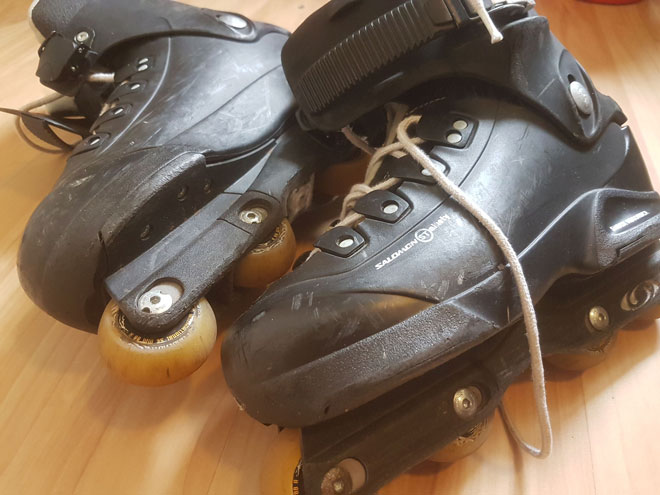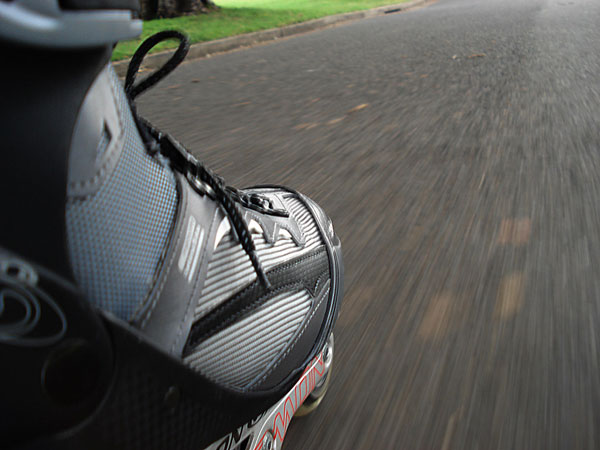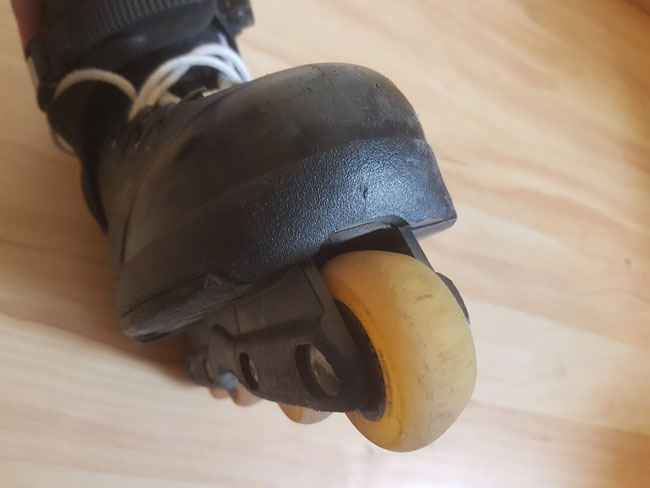Whether you’re playing ice hockey, roller hockey, figure skating or simply inline skating around your block, skates won’t last forever. Knowing how long they do and how to make them last longer can help you save money in the long run.
How long does your average pair of skates last? Anywhere from 1 – 20 years. It totally depends on quality of components, upkeep and maintenance, the type of skating you do, and how often you skate. The wheels may be the first to go, but they can be changed. The key is to clean and maintain your bearings, wheels and other parts to help them last.

It also matters what types of skates you are using, whether we’re talking ice skates for hockey, for figure skating, or inline skates with wheels. Below we’ll mostly be covering inline skating but there’s a couple of bits on ice skating that are worth skipping to if you’re interested.
Let’s dive into what determines how long your skates will last, and what you can do to make them last longer.
How Long Will MY Skates Actually Last?
Using your inline skates every day for four hours a day of aggressive inline skating and jumps, or playing roller hockey bashing into people, your skates may make it a year or two or a little more (given also that you’ll replace your wheels once or twice over that time).
But, if you go for the occasional skate once a week and look after your skates really carefully, the same skates could last you 20 years.

It depends on:
How often you use them: if you skate more often the wheels, bearings, boots and parts undergo a lot more wear and tear.
Quality of the skates (wheels, bearings, boots, other parts): some boots are better put together than others and don’t come apart so easily, some wheels and bearings last longer than others.
Quality of your maintenance (including replacing wheels, bearings, and other parts): maybe the largest factor aside from quality of skates and use which is totally under your control but many don’t take advantage of, cleaning your skates, oiling the bearings, looking after them…
Conditions you are skating in, and the type of skating you are doing: if you are landing harshly on them or bashing into other people, or suddenly accelerating, or using them in the wet, they won’t last as long as using them alone indoors to go in a slow circle…
What About Ice Skates? (Figure Skating)

Ice skates for figure skating can last many years, between perhaps 2 years – 15 years, but can lose their stiffness after a while. If you are skating several times a week on these around 1.5 hours a time, say you are doing dancing, or adult synchro, you might get them around 5 years. Between 2 and 7 years for dancing like this, then they become lose and you have to tie them tight to feel secure.
Highest level ice skaters (triple jump and above, including Olympians) may break down their boots in a couple of years or so depending on how well a fit of boot they get. They have the option of getting stiffer boots to delay that break down but that would impact their performance.
Each skater must figure out their own trade off between boot lifetime , performance, and support. Finding the absolute best fitter is a good way to do this. Boots should be snug and comfortable and cause no pain (though some very competitive athletes permit some pain).
What About Ice Hockey Skates?
Ice hockey skates, you might get 4 – 8 years out of a $500 pair if you play twice a week all year round. Plastic can start to wear out, or other wear can occur like the lace eyelets can cut through the fabric and rub your legs.
When Should You Buy New Skates?
The boots are going to last a lot longer than the bearings, wheels, and other parts like the straps and laces.
Buying new skates depends on how happy you are with the condition of your skates, and if you can still skate on them happily and without any danger.
Do they have holes or tears that impact the structural integrity? Definitely get new skates because it’s dangerous to be skating on them.
Are the wheels worn down on just one side? Well, consider swapping you wheels around to counterbalance the wear and even them out rather than buying new skates. But here you can just buy new wheels if you’re concerned about performance. Wheels might wear down in a matter of a single year rather than ten years like the boot.
Are they ice skates with a worn down steel blade? It may have worn down far enough to prevent sharpening, proper turning, or has broken. Well, you can get a replacement blade (perhaps $70) and depending on how much your skates cost you might want to just get new ones.
Are they scuffed up on the boot? Well, you can still skate on them okay so it comes down to how much you want them to look pretty.
It’s a decision based on the performance and comfort level you are willing to accept. As technology moves on you may want to upgrade your skates anyway, just the benefit from the advances that happen over the years.
If a skate has lost its stiffness (meaning it’s harder to control, and doesn’t grip your ankle as well), then you might want to consider getting a new one if you care about performance but it’s probably still okay to skate on.
Children Growing And Their Skate Sizes – When To Replace
Of course, if the skates are for a young child you’ll have to replace them when they grow out of them. It should be obvious when – they may say “ow” when trying to put the skate on, and not be able to get their foot on.
Still, it’s unwise to let your child skate in a boot that is too small for them, so keep an eye on when their feet is getting to the limit to buy them a new pair.
From 3 – 5, child’s feet grow roughly half a size every four months. Girl’s feet are supposed to stop growing at 14, whereas boys feet stop growing around 16.
When To Replace Rollerblade Wheels
The wheels are likely to be the first thing to wear out.
They get worn like this on inlines:

If you rotate the wheels by taking them out, flipping them to the other side, and changing them from the back to the middle and front, the wheels will get smaller but their wear will be more even.
So, they may go from 84s to 79s in size which will result in a speed drop, but they will still work.
So, the toe and heel wheels may wear for more easily, perhaps in 20 hours of skating, whilst the centre could last twice that.
If a split in the wheel starts to occur you have to replace your wheels immediately.
Wheels should last a decent amount of time, even if you skated 4 hours a day for 5 days a week, wheels should last at least a month.
If you find yourself replacing your wheels before this and you are not skating that often, then get a different brand or type of wheels (you could go up a durometer number).
Notably, urethane composition in the wheels can vary between them, so their hardness isn’t always a perfect way to compare between wheels. People’s personal experiences using the wheels is a good source instead. However, comparing hardness between wheels is a very good start.
How Far Down Can You Wear Your Wheel Before You Absolutely Need A Replacement?
You should not let your wheels wear down too much, the more they get wear down, the more likely splits are to develop, which can be extremely dangerous.
If you let the wheel go down about 10% of its original diameter this should be fine. So a 110 may wear down to a 99. At this stage you may want to consider changing your wheels.
So, overall, wheels could last a year or more, 6 months, or get worn down after 30 hours of skating.
Which Components on Skates Wear Out First?
As well as wheels which can wear down depending on how soft they are and how often you use them, there are other areas of your skates to keep an eye on. If you look after and then replace the components, it saves you having to buy a whole new pair of skates.
How Long Do Skate Bearings Last?
Bearings are perhaps the most delicate part of a pair of inline skates, but if you maintain them well by keeping them clean and free from dirt and grime, you should not have to replace them very often, they could last many years. However, at some point they will need to be replaced and probably around the time you notice that you can no longer glide smoothly and the maintenance isn’t helping any more.
It will come down to your own discernment as to whether it’s time or not.
Worn Down Skate Boots
Boots can get scratched up quite bad but will be still structurally sound and perfectly fine to skate on. Only when the structure is compromised in some way will you need to consider getting new boots specifically, but due to how long the plastic material can last (plastic lasts over 100 years) then it’s likely the other parts will wear out first.
Worn Down Inner Skate Shoes/Socks
The inner soles can wear down, and the socks material will wear down faster than the boot. Hygiene is an important consideration here, with anti-bacterial spray a good idea to avoid bacteria and mould forming, especially if they get wet.
Straps
Velcro straps can get worn down and deteriorate until they don’t work sticking together any more. You can limit how often you open and fasten them, if you wanted.
There are ways to keep velcro fasteners clean that you could adhere to such as spraying the velcro with an anti-static spray, using tweezers to remove stubborn debris and washing them with soap and water.
The Buckles
Notches on the buckles do also erode with time and sometimes the buckle can split. Head of the buckle, if metal, will probably last a very long time but if it’s plastic it’s might be more likely to snap, though this is not very common. Also, worth checking if the buckle is riveted in place or screwed in, and if it’s screwed in you may have to tighten it occasionally.
Laces
Laces should not slide too much and one thing you could consider is to grease or tighten them. But this is usually not necessary.
They should last longer than your wheels do, for example.
Brakes
Brakes will wear down fairly quickly, perhaps over the course of a year or more depending on how often you use them. If you’re using them loads they may last just a few months. It depends on the terrain you’re skating on as well, and your own weight will make a little bit of difference.
It’s good to have a replacement handy. And you should inspect your brake after skating to get a good idea of how quickly it is wearing out. Some brakes have a wear line indicator to let you see when it’s time to replace.
Related Questions
What will I need to maintain my skates? An Allen key and equipment to take off the wheels and bearings so you can swap the wheels around to allow them to wear down in different parts as your wheels will wear down. It’s worth having a small brush like a toothbrush to clean off dirt and grime. You’ll also need to instill a good habit, so you can pick a time when you plan to wash and look after your skates so you actually do it!
How many times a year will I need to replace my skates? With a good pair of skates probably only once every five years or so, depending on how often you are skating.

